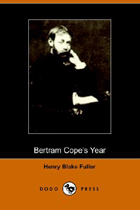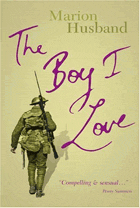 Tony
Heyes, our man from England, gives us a double review of Bertram Cope's Year and The Boy I Love.
Tony
Heyes, our man from England, gives us a double review of Bertram Cope's Year and The Boy I Love.I call it a "double review" for lack of a better term. It's a single review of the two books.
Check out Tony's other reviews in this online magazine by using the search engine on the Portal Page

 Bertram
Cope’s Year
Bertram
Cope’s YearBy Henry Blake Fuller
Published by Turtle Point Press 1998
ISBN 1-885983-26-3
The Boy I Love
By Marion Husband
Published by Accent Press Ltd 2005
ISBN 1905170009
By a strange coincidence these two books swam into my ken at the same time. I say “strange” because both books are set in 1919, although they were published eighty-six years apart and on opposite sides of the Atlantic. Never was the opportunity to “compare and contrast”, as one used to be asked in examination papers, more obviously present.
The books differ quite markedly from one another in style. Bertram Cope’s Year was quite obviously written in more leisurely times. The language is elaborate, measured and circumspect. One might easily be embarking on a work by Henry James or Edith Wharton. The similarity ends with the style, however, for the novel’s subject matter is not the sort of thing that either of them would have touched with a bargepole: homosexuality. Of course, it is never referred to as such. (It can be argued that in The Bostonians and The Pupil James does deal with homosexuality but he does it so obliquely that it is easily missed).
Bertram Cope is presented to us as a young man who has no inclination to marry. His aversion to the opposite sex is such that the very idea makes him shudder. Unfortunately for him he is very good looking, young and eligible at a time when young women were faced with only two choices, marriage or penury. He is regarded as a good “catch”. Bertram himself is longing for the time when his dear friend, Arthur, will join him from home and they can set up house together. Bertram has reckoned without Medora Phillips. Mrs. Phillips is a rich widow who likes to orchestrate local society. Mr. Cope, she decides, will be a valuable addition to her circle and so is taken up by her. She has three young, female relations staying with her. They are, rather schematically, a painter, a poet and a musician. By being impeccably polite Bertram finds himself being regarded by one of them as having a more than friendly interest in her and when they find themselves in the sea together and nearly drown, he is hailed as the hero of the hour, her saviour. Bertram himself is not quite sure who saved whom. In no time at all he finds himself, very much against his will and to his horror, engaged to her.
At the same time he is being cultivated by one Basil Randolph, a confirmed bachelor of maturer years who shares his proclivities and tries to draw him nearer. Bertram plays hard to get and is polite but distant. His friend Arthur comes to take up residence with him. He is a student at the college, has a part-time job and flings himself into an all male theatrical production, playing a female part. Most people find him too convincing. He is flouncy and swishy and increasingly too effeminate for Bertram’s taste. In the end Bertram’s engagement is broken off. Arthur returns home and Bertram distances himself from his Mrs. Phillips’ circle, alienating the violinist who, it seems has been secretly carrying a torch for him.
It is remarkable that throughout the entire novel the proprieties are observed. Bertram makes it quite clear that he is not the marrying kind. Those similarly inclined recognise him as a fellow homosexual whilst straight society feels he only requires the love of a good woman to set him on the right path. Bertram will have none of this, ploughing his own furrow despite all obstacles. To the modern reader it is fascinating that such a book could be written at such a time. Homosexuality then was a taboo subject yet the author manages to deal with it as openly as possible without ever mentioning it. It is obvious that people then were far more aware of realities than we sometimes credit them with being. They just approached them more obliquely than we do. Once the reader becomes familiar with the books leisurely pace, an interesting insight into another age is gained. Well worth a read.
The Boy I Love is a different kettle of fish in terms of style. Indeed, the author makes little attempt to accommodate herself to the speech patterns, vocabulary and general feel of the period. The book’s title is taken from a music hall song, “The Boy I Love is up in the Gallery” (rendered, unaccountably, “balcony” in the book) which was sung by the soldiers in the trenches in the First World War.
The book’s hero, Paul Harris, has returned from the First World War physically and psychologically scarred. He has been in a mental hospital with shell-shock and has lost one eye. He still has frightening nightmares and is physically frail. Despite this, he has great integrity and moral courage. His older brother, Robbie, was killed in the war. Robbie’s fiancée, Margot, was the local vicar’s daughter. She is pregnant and beside herself about what to do about the baby. Her mother wants her to give it up for adoption. Paul gallantly proposes to her so that she can keep the baby. Her pregnancy is not so far advanced that they can’t pass it off as his child.
The vicar, one of the most unsympathetic characters in the book, has his suspicions. He has always regarded Paul as something of a milksop and now that his stunning good looks have been blighted he is less of a catch than he might have been. He also has difficulty in believing Paul has got his daughter pregnant.
Paul meanwhile is still involved with his old, pre-war friend, Adam, and with Patrick, a local butcher with whom he served in the war and whom he truly loves. The wedding goes ahead. Eventually it is consummated. The child is born and Paul renounces his homosexual friends to honour his new commitments.
Marion Husband relates this story extremely well. The reader is fully engaged and feels (at least this one did) great sadness at Paul’s grand renunciation. My only reservation, as I remarked at the beginning of this review, is the absence of any real period feel. Educated as I was as a child by Edwardian teachers, women who were then known as “maiden ladies”, who had never married because the flower of England’s youth had been wiped out in France, I was very aware of their speech patterns and outlook. There is no hint of that in this novel which seems very contemporary apart from the need to save Margot’s “honour”. Nonetheless, this is a fine and thought-provoking book, well-organised and totally believable. Had The Boy I Love created the same atmosphere as Bertram Cope's Year it would have been nearly perfect. As it is it deals honestly but somewhat anachronistically with its subject matter.